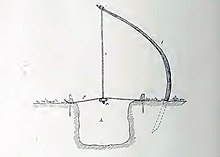|
Ground bow The ground-bow, also known as an earth-bow or ground harp,[1] is a single-string bow-shaped folk musical instrument, classified as a chordophone. It is known in cultures of equatorial [2] and south[3] Africa, and in other cultures with African roots. It consists of a flexible stick planted into the ground (possibly a stripped sapling or a branch[4]), with a string from its free end to a resonator of some kind based on a pit in the ground.[5] It looks like a game trap or a child toy, therefore its distribution over Africa used to be overlooked. Hornbostel (1933) classified is in the category of harps, although it has combined characteristics of a harp and a musical bow.[4] The resonator may be a pit covered by a board, with string attached to it.[5] Kruges describes several other constructions by Venda, e.g., the other end of a string is tied to a stone dropped into the pit, with string passing through the board covering the pit, etc.[4] Other names include kalinga or galinga by Venda people. In their language "galinga" means simply a hole in the ground, while the origins of "kalinga" are uncertain.[4] It is known as gayumba in Haiti,[6] Dominican Republic,[7] and tumbandera in Haitian traditions of Cuba.[6][8] Baka people call it angbindi.[9] It is also known in Cuba under the onomatopoeic name tingo-talango (tingotalango).[10][11] Julio Cueva's song Tingo Talango dedicated to this musical instrument describes its construction thus:
The instrument is reportedly nearly-extinct in the native cultures.[4][6] Playing techniquesKalinga may be struck by a stick or plucked in various ways. The bow stick may be bent to change the tension of the string, and hence the tone. It can be played in a glissando manner: the stick is bent, struck, and released, producing a peculiar sound. The produced pitches are not always stable.[4] Kalinga is usually played to provide repetitive accompaniment to the choral song.[4] See alsoReferences
Further reading |